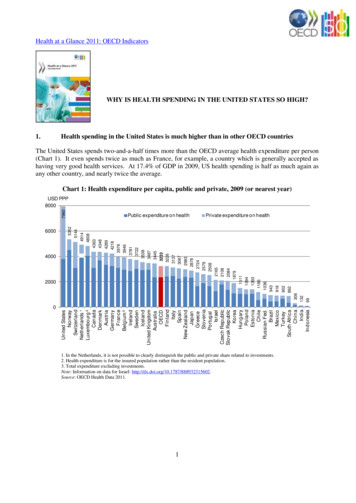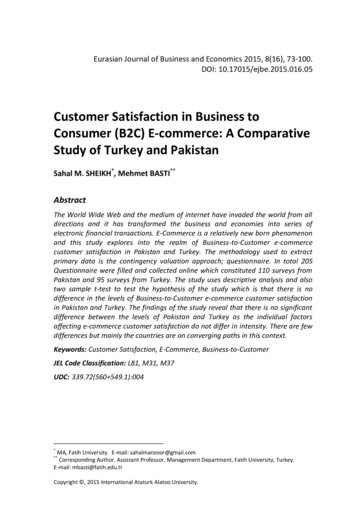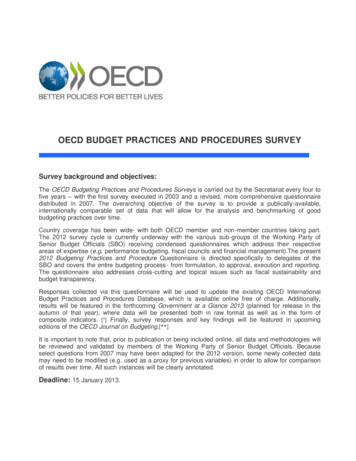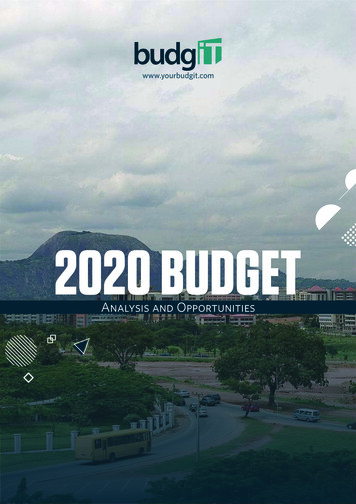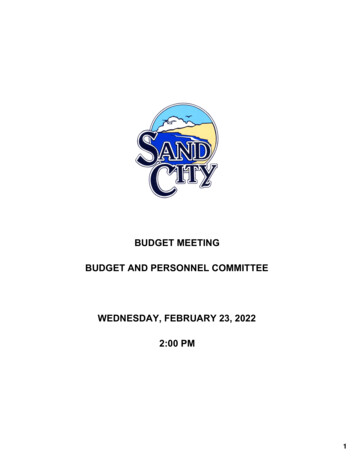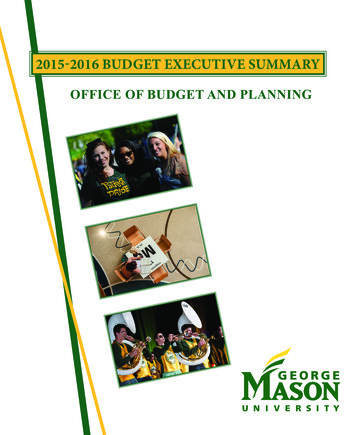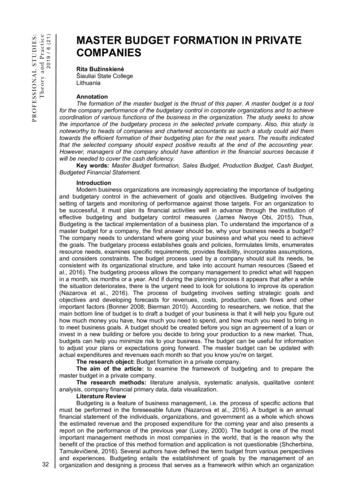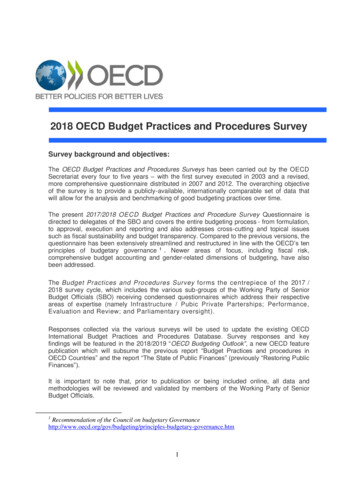
Transcription
2018 OECD Budget Practices and Procedures SurveySurvey background and objectives:The OECD Budget Practices and Procedures Surveys has been carried out by the OECDSecretariat every four to five years – with the first survey executed in 2003 and a revised,more comprehensive questionnaire distributed in 2007 and 2012. The overarching objectiveof the survey is to provide a publicly-available, internationally comparable set of data thatwill allow for the analysis and benchmarking of good budgeting practices over time.The present 2017/2018 OECD Budget Practices and Procedure Survey Questionnaire isdirected to delegates of the SBO and covers the entire budgeting process - from formulation,to approval, execution and reporting and also addresses cross-cutting and topical issuessuch as fiscal sustainability and budget transparency. Compared to the previous versions, thequestionnaire has been extensively streamlined and restructured in line with the OECD’s tenprinciples of budgetary governance 1 . Newer areas of focus, including fiscal risk,comprehensive budget accounting and gender-related dimensions of budgeting, have alsobeen addressed.The Budget Practices and Procedures Survey forms the centrepiece of the 2017 /2018 survey cycle, which includes the various sub-groups of the Working Party of SeniorBudget Officials (SBO) receiving condensed questionnaires which address their respectiveareas of expertise (namely Infrastructure / Pubic Private Parterships; Performance,Evaluation and Review; and Parliamentary oversight).Responses collected via the various surveys will be used to update the existing OECDInternational Budget Practices and Procedures Database. Survey responses and keyfindings will be featured in the 2018/2019 “OECD Budgeting Outlook”, a new OECD featurepublication which will subsume the previous report “Budget Practices and procedures inOECD Countries” and the report “The State of Public Finances” (previously “Restoring PublicFinances”).It is important to note that, prior to publication or being included online, all data andmethodologies will be reviewed and validated by members of the Working Party of SeniorBudget Officials.1Recommendation of the Council on budgetary ples-budgetary-governance.htm1
Deadline: The final survey responses are due 31 January 2018. The questions have been redesigned in many cases, with a view to enhancing clarity and ease of response.Action:Please note that the PDF document attached to the e-mail invitation is intended forreference only, to help plan your responses and coordinate with colleagues/otherrespondents. Responses must be submitted via the online questionnaire using the linkprovided. The use of the online instrument will help improve data quality and comparability.Via email, the Secretariat will provide delegates to the SBO with a web link to thequestionnaire, as well as the corresponding username and password needed to access it.The online questionnaire tool allows respondents to start and stop the questionnaire at yourconvenience (answers will be saved), and to share the responsibility of responding with otherofficials/experts. Further technical instructions will also be provided by email.Delegates are asked to kindly nominate a respondent(s), coordinate with the respondent(s)to finalise answers, and liaise between the OECD and the respondent(s) after finalsubmission should any further clarification or verification be needed. SBO Delegateshowever are responsible for the validation and accuracy of the final submission of data.Prior to and during completion, respondents are encouraged to consult your previous surveyresponses at:International Budget Practices and Procedures ionalBudgetPracticesandProceduresDatabase.htmOECD (2014), Budgeting Practices and Procedures in OECD countries, OECD -enDefinitions of key terms:When completing this questionnaire, kindly review and actively refer to the Glossary of KeyTerms. In the majority of instances, OECD definitions have been applied as published in theOECD Journal on Budgeting.It is possible that the terminology applied in this questionnaire may not exactly match - ormay not be applicable - to the particular context in your country. In such cases, please usethe comments section (or other space provided) to specify the terminology used in yourcountry and clarify your choice of response. This additional clarification will enhancecomparability and data quality.OECD Journal on Budgetinghttp://www.oecd.org/document/0,3746,en 2649 34119 2074062 1 1 1 1,00.htmlHelp:For further assistance, information or advice in completing this questionnaire please nieDOWNES(Ronnie.DOWNES@oecd.org). If a respondent encounters questions which they find verydifficult or resource-intensive to answer, they should not hesitate to contact the Secretariatfor assistance.2
Important guidelines for completing the questionnaire:Respondents of questionnaireAs previously mentioned, delegates to the SBO are asked to nominate a respondent orgroup of respondents that they deem qualified to answer the enclosed questions. Theseshould be firstly from Central Budget Authority (CBA) and specifically, from a Division/Unitresponsible in the Executive responsible for budget formulation and oversight. If theseresponsibilities are shared by different Divisions/Units within or outside of the CBA,stakeholders from all applicable institutions should be involved in responding to thequestionnaire. In such cases, SBO delegates are kindly asked to facilitate this process andtake ownership/responsibility for the accuracy of the final submission.Scope of questionnaireWith very few exceptions (which are clearly indicated), respondents are asked to provideinformation or data on the policies and practices in place in central / federal government.While this limits the scope of the responses and will not capture the activities of sub-nationalgovernments (which account for a large proportion of expenditures within many countries), itensures that the data are comparable across all responding countries.Data availabilitySeveral questions in the questionnaire will ask countries to provide quantitative data. If thisdata is not available, if it is being provided for a time period other that what is asked in thequestion, or if there are important caveats that should be known, please be sure to notethese in the comments section provided.3
RESPONDENT(S’) CONTACT INFORMATIONContact: Please provide the contact information for the main person responsible forresponding to this questionnaire. This information will be used by the OECD in case followup is needed to clarify responses to enhance data comparability across countries. If youwould like to list multiple contacts, you can enter the information for the additional staff atthe end of this page.* Surname (s):* First Name (s):* Respondent’s institution (name and web link of Central Budget Authority, LineMinistry/ Department or Executive Agency under Line Ministry/Department):* Position/title:* Email address (summary of responses will be sent automatically to this address uponcompletion):* Telephone:Names and emails of additional respondents, if applicable:4
Structure of Questionnaire:General information1. Budgeting within Fiscal Objectives1.1 Framework to promote sound and sustainable fiscal policy1.2 Fiscal objectives and fiscal rules1.3 Budgetary management within overall fiscal policy2. Alignment with Medium-term Strategic Plans and Priorities2.1 Medium-term strategic planning2.2 Medium-term expenditure framework3. Capital Budgeting Framework (separate survey via Infrastructure and PPPs network)4. Transparency, Openness and Accessibility4.1 Clear budget information4.2 Openness of budget data4.3 Budgetary impact assessment – Gender budgeting5. Participative, Inclusive and Realistic Debate5.1 Parliament engagement5.2 Realistic debate on budgetary choices6. Comprehensive, Accurate & Reliable Account of Public Finances6.1 Institutional coverage6.2 Comprehensiveness of budget documentation6.3 In-year and year-end reporting7. Effective Budget Execution7.1 Full and faithful implementation7.2 Allowing limited flexibility8. Performance, Evaluation and Value for Money (separate survey via Performance andResults network)9. Fiscal Risks and Sustainability9.1 Long-term fiscal sustainability9.2 Fiscal risks10. Quality, Integrity and Independent Audit10.1Independent audit10.2Independent fiscal institutions5
General Information1a. Where is the function of the Central Budget Authority (CBA) located in yourgovernment?Please select onea. Ministry of Finance/Economyb. President’s Officec. Prime Minister’s Officed. Independent agencye. CBA is split between two or more Ministries/Agenciesf. Other, please specify:Additional Comments:Please use this space as needed to clarify your response above (particularly, if option d or e is selected)1b. Please provide the formal name of the CBA in your country along with a correspondingweb link:2. Please indicate whether the head of the CBA is:Please select onea. A career civil servant (e.g. a government official who ordinarily remains in this position when there is achange in Government.)b. A political appointee (e.g. a person who generally does not remain in this position when there is a changein Government)c. Other, please specify:6
3. In practice, please indicate which of the below activities are responsibilities of the CBA.Please select one choice per rowi. Soleresponsibilityof the CBAiv. Notii. Sharedapplicable (e.g.responsibilityiii. Not aactivity notbetween the responsibilityperformed)CBA and other of the CBAinstitutionsa. Drafting the Budget Circularb. Developing methodology/modelsfor macroeconomic projections (e.g.economic growth, inflation etc.)c. Developing methodology/modelsfor fiscal projections (e.g. revenues,expenditures, fiscal stance, etc.)d. Determining final budget ceilingsfor aggregate/overall expenditurese. Determining final budget ceilingsfor line ministriesf. Conducting negotiations with lineministries/agenciesg. Developing Executive’s budgetproposalh. Testifying before Legislaturei. Authorisation of line ministries’outlaysj. Monitoring performance of lineministries/agenciesk. Producing supplementary budgetl. Producing mid-yearimplementation reportm. Producing y e a r- end budgetexecution reportsn. Producing year-end financialstatementso. Controlling public/civil serviceemployment (e.g. wage envelope,employment numbers)p. Communications (with public,media)q. Other key responsibility, pleasespecify:7If (ii) is chosen,please providename(s) of otherinstitution(s)involved, includingnon-governmental
4. Please provide the number of full-time staff employed in the CBA, if possible, in terms offull-time equivalents (FTE):Indicate whether the figure isa head-count or FTENumber of staffTotal full-time staffComments, if any:Head countFTE5. Please indicate which of the following are produced / published:Please select one choice per rowPublicly availablea. Methodology and assumptions forestablishing fiscal projections used in thebudgetb. Sensitivity analyses of fiscal and/ormacroeconomic modelsc. Independent reviews/analysis ofmacroeconomic and/or fiscal assumptionsd. Budget circulare. Pre-budget fiscal policy statementf. Medium-term expenditure frameworkg. Executive’s budget proposalh. Approved budgeti. Supplementary budgetj. Pre-execution budget profilesk. In-year budget execution reportsl. Mid-year implementation reportm. Year-end budget execution reportsn. Year-end financial statementso. Long-term fiscal sustainability reportp. Report on fiscal risksq. Pre-election reportr. Report on tax expendituress. Debt management reportt. Assets and liabilities (or balance sheet)management reportu. Other, please specify:8Produced but notpublicly availableNot applicable (e.g. notproduced by government)
6. What, if any, is the legal basis for each of the following?For each row, please select all columns that applyStipulated intheConstitutionStipulated inlawStipulated inregulationa. The form and structure of theannual budget (e.g. theorganisation, form of itemisation,the types of supplementaryinformation which must beincluded, etc.)b. The roles and responsibilitiesof the different parts of theExecutive in budget formulationand execution (e.g. division ofresponsibilities between CBA, LineMinistries and President’s / PrimeMinister’s office in budgetpreparationandspendingprocedures)c. The roles and responsibilities ofthe Legislature and the Executivein the budget process (e.g.divisionofresponsibilitiesbetween the Executive andLegislature in budget review,approvalandspendingprocedures)d. Provisions for what happenswhen the budget is not approvedby the beginning of the fiscal yeare. Requirement for legislativeauthorisation of spendingf. Requirement for legislativeauthorisation of additional taxesand/or tax reformsg. Medium-term expenditureframeworkh. Provisions relating to inclusionof environmental issuesi. Management and reportingrelatingtooff-budgetexpendituresj. Rules for the use of contingencyreserve fundsk. Requirements for internal auditstructures in line ministriesl. Requirement for audit ofgovernment accounts by theSupreme Audit Institutionm. Public employment provisions(e.g. terms and conditions of civilservants)9Stipulated inorganisational orinternal rulesNo formalbasisNotapplicableComments(especially ifmore thanone answer)
7. Generally speaking, what is the timeframe of the budget cycle?.Indicate the date/month forthis milestone (month ismandatory while date mayvary and is optional).If "Not applicable" pleaseindicate in this box.a. When does the fiscal year start?If date varies each year, indicatewhether this milestone usuallyoccurs in the beginning, middle orend of the month.Beginning of the monthMiddle of the monthEnd of the monthBeginning of the monthMiddle of the monthEnd of the monthBeginning of the monthMiddle of the monthEnd of the monthBeginning of the monthMiddle of the monthEnd of the monthBeginning of the monthMiddle of the monthEnd of the monthBeginning of the monthMiddle of the monthEnd of the monthBeginning of the monthMiddle of the monthEnd of the monthBeginning of the monthMiddle of the monthEnd of the monthBeginning of the monthMiddle of the monthEnd of the monthBeginning of the monthMiddle of the monthEnd of the monthBeginning of the monthMiddle of the monthEnd of the monthBeginning of the monthMiddle of the monthEnd of the monthb. When are initial spendingtargets/ceilings communicated to lineministries?c. When do line ministries generallyprovide their first budget proposals tothe CBA?d. By when must the Cabinet approvethe Executive Budget Proposal?e. When is the Pre-budget fiscalpolicy statement published?f. When is the Executive BudgetProposal submitted to the Legislature?g. By which date must the Legislaturevote to approve the tax policy measuresin the budget?h. By which date must the Legislaturevote to approve the expenditure policymeasures in the budget?i. When does the ion reportj. When do central/federal public sectorentities issue their respective individualyear-end reports?k. When does the central/federalgovernment issue consolidated, centralgovernment year-end reports?l. When does the supreme auditinstitution publish its audit report onthe consolidated, central governmentyear-end reports?m. When does the Parliament begin todiscuss the consolidated, centralgovernment year-end reports?n. Other major milestone, pleasespecify:Beginning of the monthMiddle of the monthEnd of the monthBeginning of the monthMiddle of the monthEnd of the month10Comments,if relevant
1Budgeting within Fiscal Objectives1.1 Framework to promote sound and sustainable fiscal policy8. What procedures are in place to promote sound and sustainable fiscal policy?Please select all that applya. No specific procedures are in place: each new government has full freedom of action to pursue fiscal policyin line with its own political mandate and prioritiesb. It is an established political convention (not a constitutional/legal requirement) that each new governmentmust set out clearly its medium-term fiscal policy objectives, for which it will be held publicly accountablec. It is a legal (and/or constitutional) requirement that each new government must set out clearly itsmedium-term fiscal policy objectives, for which it will be held publicly accountabled. The national constitution sets out one or more specific fiscal rules, with which the government is expectedor required to complye. National legislation sets out one or more specific fiscal rules, with which the government is expected orrequired to complyf. Binding international agreements or treaty obligations (e.g. EU treaties) set out one or more specific fiscalrules, with which the government is expected or required to complyg. Other, please specify:9. Which of the following actors is primarily responsible for the development of themacroeconomic estimates underlying the budget projections?Please select onea. Central budget authority (CBA)b. M in is try o f Finan ce/E con omy (o th er d ep ar tmen ts )c. President's officed. Prime Minister’s officee. Other government body (e.g. ministry or agency)f. Legislature or legislative bodyg. Private sectorh. Independent body (outside of legislature and executive)If you selected option e, f, g or h above, please specify in detail below.11
1.2 Fiscal objectives and fiscal rules10. Please describe briefly the fiscal objectives and/or fiscal rules (including targets and escapeclauses) currently in place in your country at central/federal level:11. Please indicate the fiscal objectives/fiscal rules in place in your country at central/federallevel, and their legal/administrative basis:Please select one choice per rowConstitutionLawCoalitionagreement /politicalcommitmentInternalrules /policies1) Budget balancea. Headline/nominal budgetbalanceb. Structural/cyclical budgetbalancec. Primary budget balanced. “Golden rule”e. Other budget balance,please specify:2) Debtf. Debt ceiling in a level or asa percentage of GDPg. Debt reduction targeth. Debt target in a level or asa percentage of GDPi. Other debt, please specify:3) Expenditurej. Expenditure level/ceilingk. Expenditure growth rate12InternationaltreatyOtherbasisNotapplicableIf otherbasis,pleasespecify:
l. Other expenditure, pleasespecify:4) Revenuem. Upper limits on revenuen. Constraints on allocationof higher than expectedrevenueso. Other revenue, pleasespecify:5) Other fiscal objective /rulep. Other, please specify:12a. In case of non-compliance with the fiscal objectives/fiscal rules, what enforcementprocedures are in place?Please select all that applya. There is no enforcement procedures defined ex anteb. There are automatic correction mechanismsc. There are automatic sanctionsd. The government entity responsible for the overrun must implement corrective measurese. There is a requirement to propose corrective measures to the Legislaturef. There is a requirement to explain the reasons for non-compliance to the Legislatureg. Other, please specify:12b. please describe briefly enforcement procedures indicated above:13
1.3 Budgetary management within overall fiscal policy (“top-down” budgetary management)13. What type of information is contained in the annual budget circular/memorandum issuedby the CBA to guide line ministries’ preparations of budget proposals/budget estimates?Please select all that applya. There is no such circular/memob. A set of rules for the budget process and the main forms/templates to be used in the estimates submissionc. The macroeconomic assumptions to be used in the processd. Information on government policy prioritiese. Expenditure ceilings or allocationsf. Specific provisions for managing/controlling public/civil service employmentg. Guidance on including an income/poverty impact perspective within the budget proposals/estimatessubmissionsh. Guidance on including an environmental/climate perspective within the budget proposals/estimatessubmissionsi. Guidance on including a gender equality perspective within the budget proposals/estimates submissionsj. Other, please specify:14. Does the government impose budget ceilings on the initial spending requests of each lineministry?Please select all that applya. Nob. Yes for overall/total expenditure of the line ministryc. Yes for other aggregate levels (e.g. by programme or sector)d. Yes for agency level or other organisational levele. Other, please specify:15. If budget ceilings are imposed on line ministries, what are the characteristics of theseceilings?Please select onea. All budget ceilings are made publicb. Budget ceilings on each line ministry are shared only within the governmentc. Budget ceilings on each line ministry are shared only with the relevant line ministryd. Other, please specify:14
16. What happens if each line ministries’ initial spending requests are higher than the imposedbudget ceilings?Please select onea. There is no penalty; the spending requests are discussed within governmentb. Mandatory reduction is applied to the spending request in line with imposed budget ceilingsc. Mandatory reduction is applied to the spending request to below the imposed budget ceilingsd. A non-financial disincentive (e.g. low institutional evaluation) is given to the line ministrye. Other, please specify:If you selected option b, c or d above, please clarify response.17. During the budget negotiation process between the CBA and line ministries, who has thefinal/ultimate decision-making power to resolve/settle disputes?Please select onea. Presidentb. Prime Ministerc. Minister of Finance / Economyd. Cabinete. Ministerial committeef. Other, please specify:15
2Alignment with Medium-term Strategic Plans and Priorities2.1 Medium-term strategic planning18. In your country, which institutions are most important in determining the medium-termstrategic plans and priorities of the government?Please select onea. There are no medium-term strategic plans and prioritiesb. Coalition political parties / leaders in governmentc. Central Budget Authorityd. Other institutions at the Centre of government (e.g. President’s Office, Prime Minister’s office, Cabinet office)e. A Committee of government / cabinetf. Ministry of Planning / National Developmentg. Other, please specify:19. Please indicate which of the documents listed below set out the medium-term strategicplans and priorities of the government?Please select all that applya. Government Programme / Coalition Agreementb. National Development Planc. Approved Set of National Outcome Objectives / Well-being Goalsd. Medium-term expenditure frameworke. Other, please specify:20. What tools or procedures are in place to promote alignment between the annualbudgetary allocations, and the medium-term strategic plans and priorities of the government?Please select all that applya. There are no alignment tools or procedures in placeb. Informal and/or ad hoc coordination mechanisms between relevant ministries / agenciesc. CBA has a leadership role in promoting alignment between annual budgets and medium-termplans/prioritiesd. Other institutions at the Centre of government (e.g. President’s office, Prime Minister’s office, Cabinetoffice) have a leadership role in promoting alignment between annual budgets and medium-term plansand priorities16
e. Coordination and alignment is handled via discussions at Cabinet / Council of ministersf. Specific sub-committees of Cabinet / Council of Ministers handle coordination and alignmentg. The medium-term strategic plan has annual milestones and resourcing indications, which facilitatealignment with the annual budgetary allocationsh. The medium-term expenditure framework explicitly aligns budgetary allocations with medium-term plansand prioritiesi. Other, please specify:2.2 Medium-term expenditure framework21a. Does your government have a medium-term expenditure framework (MTEF) in place?Please select onea. No (skip to Question 29)b. Yes (continue to Question 21b)21b. Please describe briefly how your country operates the MTEF?22. Which of the following is the legal / policy basis for the MTEF?Please select onea. A law stipulating that aggregate / overall public spending should be managed in line with medium-term limitsb. A law stipulating the creation of a MTEF, whereby annual budgets are managed in line with indicativemedium-term ceilingsc. A law stipulating the creation of a MTEF, whereby annual budgets are determined on the basis of fixedmedium-term ceilingsd. A strategy/policy stipulating the MTEF and/or budget ceilingse. Other, please specify:23. To what areas of spending do the medium-term expenditure ceilings apply in the annualbudget?Please select all that apply17
a. MTEF ceilings are for the overall / total expendituresb. MTEF ceilings are for other aggregate levels (e.g. programme or sector)c. MTEF ceilings are set at the organisational level (e.g. the ministry level or other agency)d. MTEF ceilings set at other level. Please specify:24. What are the main characteristics of the MTEF?Please select one choice per columni) How many years do theceilings cover (includingupcoming budget whileexcluding planning year)?MTEFii) Is the framework fixedover the defined period orrolling forward regularly?iii) How often are the annualceilings revised (apart fromtechnical adjustments)?a. 2 yearsa. Fixed perioda. Not revisedb. 3 yearsb. Rolling basisb. More than once per yearc. 4 yearsc. Annuallyd. 5 yearsd. Every 2 to 3 yearse. 6 years or moree. Once per fixed periodf. OtherIf you selected option e. 6 years or more in i) above, please clarify.If you selected option f. Other in iii) above, please clarify.25. Who has main responsibility for approving the MTEF?Please select onea. Minister of Finance / Economyb. The Head of government (President, Prime Minister)c. The Cabinet / Council of Ministersd. A Sub-committee of the Cabinet / Council of Ministerse. The Legislaturef. Other, please specify:18Please comment(e.g. option “6years or more”and/or “Other”)
26. What areas of public expenditure are covered by the MTEF?Please select all that applya. Mandatory spendingb. Discretionary Spending (excluding operational spending)c. Operational spendingd. Investment spendinge. Other, please specify:27. How is the MTEF mainly monitored/reported on?Please select onea. No formal monitoring or reportingb. Internal monitoring within government (e.g. Minister of Finance reports to Cabinet / Council of Ministers)c. Government reports to parliamentd. Independent monitoring / fiscal institutione. Other, please specify:28. Does the MTEF include specific estimates/limits regarding spending on pay for publicemployees?Please select all that applya. Nob. Not directly, but such spending is covered by unallocated contingency reservec. Yes estimates are calculated based on past trendsd. Yes there are specific limits at aggregate levele. Yes there are specific limits for each line ministry / agencyf. Other, please specify:3Capital Budgeting FrameworkThis section of the survey will be processed separately by the Infrastructure and PPPs network19
4Transparency, Openness and Accessibility4.1 Clear budget information29. Which of these budget impact analyses are published?Please select one choice per rowFor individualmeasuresFor the budgetas a wholeNot publisheda. Effects on households at different levels of incomeb. Effects on overall income inequality (e.g. Gini coefficient)c. Effects on poverty/social deprivationd. Gender impactse. Impacts on different age cohortsf. Impacts on minority groupsg. Regional distribution of budget costs / benefitsh. Environmental impacts / Climate changei. Effects on range of societal wellbeing indicatorsj. Other, please specify:4.2 Openness of budget data30. Please indicate what kinds of budget guides/data are produced/published in addition tothe following budget-related documents?For each row, please select all that applyOfficialSummary forpolicy-makersa. Pre-budget fiscal policy statementb. Medium-term expenditure frameworkc. Executive’s budget proposald. Approved budgete. Supplementary budgetf. Mid-year implementation reportg. Year-end budget execution reportsh. Year-end financial statementsi. Long-term fiscal sustainability reportj. Report on fiscal risksk. Other, please specify:20Citizen’sGuideOpen DataOther,please specify:
31. How is open budget data made available?Please select all that applya. Not availableb. Yes, budget data is available in downloadable form (e.g. spreadsheet)c. Yes, on-line budget data portal from the CBA that allows user-defined dynamic queriesd. Yes, on-line centralized government data portal that allows user-defined dynamic queriese. Yes, data-visualisation tools covering most or all areasf. Other, please specify:4.3 Budget impact assessment – Gender budgeting32. Does your country currently practise some form of gender budgeting?Please select onea. No (skip to Question 36)b. Yes (continue to Question 33)33. What is the legal basis or authority for conducting gender budgeting?Please select one choice per rowLegal basis/authorityYesNoYear of introductionComments, ifany:a. Constitutional requirementb. Budget lawc. Other specific legislationd. High level political commitment/conventione. Compliance with international law or instrumentf. Administrative practice (e.g. Budget Circular)g. Other, please specify:34. Please indicate specific ways in which gender budgeting is implemented in your country.Note that each of the terms listed below is defined in the Glossary.Please select all that applyTool/methodimplementedBodies involvedCBAYesNoOtherinstitutions atthe centre ofgovernment21LineministriesIndependentbody with aspecificmandateCo
2018 OECD Budget Practices and Procedures Survey Survey background and objectives: The OECD Budget Practices and Procedures Surveys has been carried out by the OECD Secretariat every four to five years - with the first survey executed in 2003 and a revised, more comprehensive questionnaire distributed in 2007 and 2012. The overarching objective

